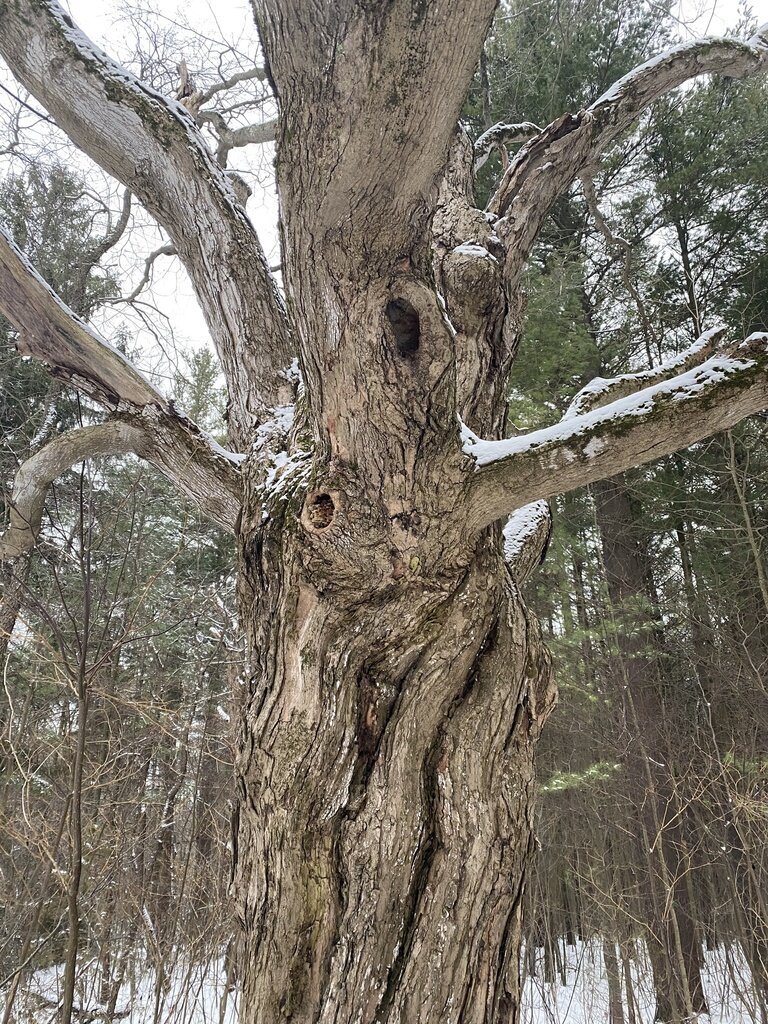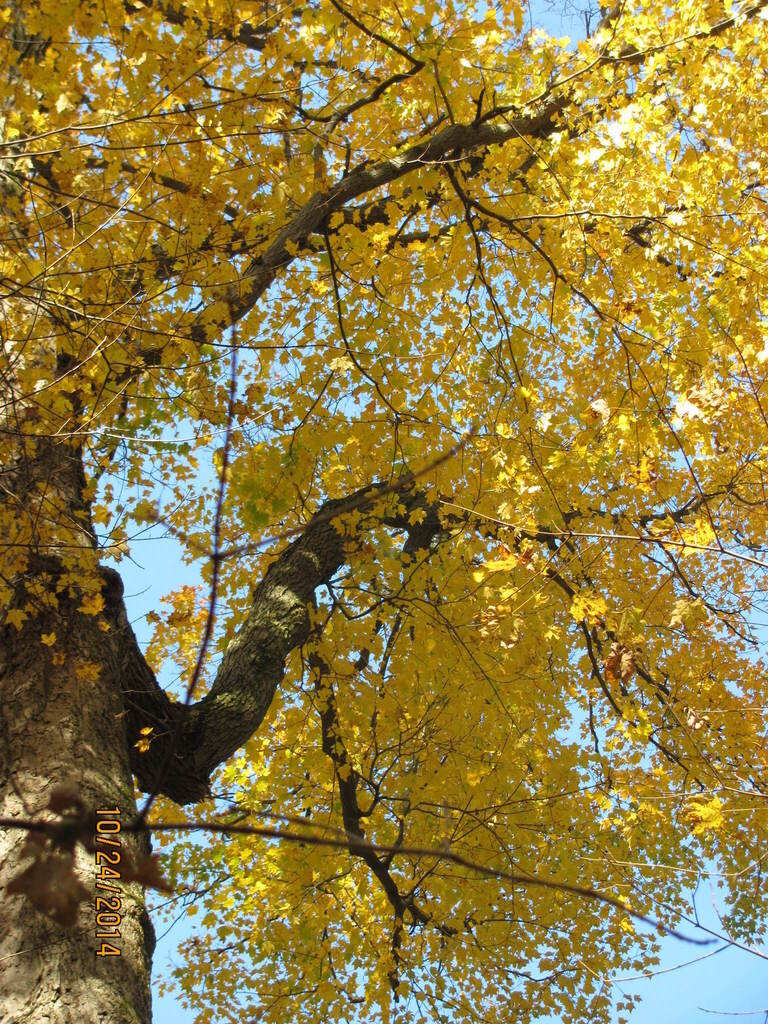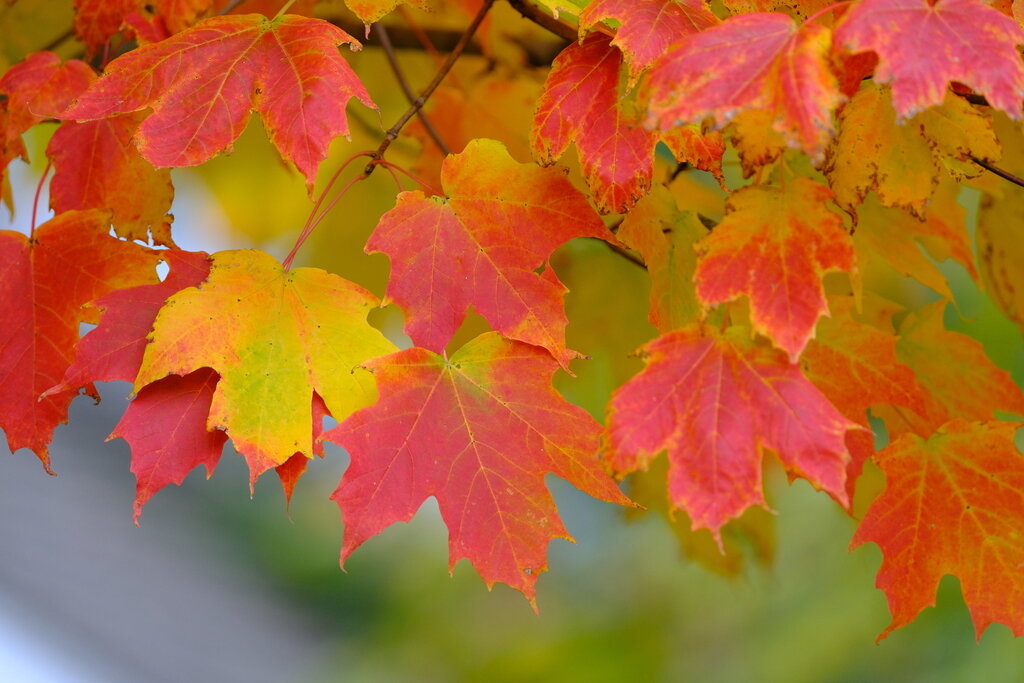Sugar Maple
Acer saccharum
Long-lived and relatively slow-growing, the sugar maple (Acer saccharum) is a large deciduous tree with a rounded, dense crown. It typically grows to 70-100 feet in natural conditions and can have a diameter of 2-3 feet, although they can grow significantly larger. Being essentially a dioecious species, each tree will produce either male or female flowers, but some individuals can exhibit monecious tendencies, especially on different branches. The flowers of this tree are small, yellow, and inconspicuous, and appear with leaf break in early spring. They produce a winged fruit called a samara. These seeds are commonly known as “helicopter seeds,” as they spiral to the ground in early fall. The sugar maple exhibits an oppositely arranged leaf formation that is palmately lobed with five deep long-pointed lobes which have few narrow long-pointed teeth. The leaves typically have a rich yellow or orange hue in the fall, although there is some variation. The bark is light grey-brown, becoming darker, rough, and deeply furrowed into narrow scaly ridges as the plant matures.
Habitat
The sugar maple is a cold-hardy species and prevalent in much of the mixed hardwood forest of the eastern U.S. Its range extends south from Canada to the mountains of northern Georgia, and southwest to Missouri. This maple species is considered widespread in its native range but becomes less prevalent and more restricted as you go south into warmer climates. In the northeast part of its range, the tree inhabits elevations up to 2500’, and in its southern ranges, the sugar maple typically occurs at higher elevations of 3000’ - 5500’ which supports the maple’s love for cool, moist environments.
Acer saccharum typically occurs in cove forests and other rich, mesic forests, especially over areas abundant in magnesium, iron, and lime. This species can also be found in dry forests and upland woods, and less typically will extend into high elevation northern hardwood forests with acidic conditions. The sugar maple is intolerant of pure sand, swampy soils, and xeric conditions. Like most other maples, the sugar maple seems to be extremely shade tolerant and prospers in forest complexes where it acts as an understory plant, capitalizing on canopy light-gaps with rapid growth towards the sun.
© Chuck Thomas, some rights reserved (CC-BY-NC); © thepaulabrent, some rights reserved (CC-BY-NC); © marlenekraml, some rights reserved (CC-BY-NC)
Uses
Acer saccharum makes an excellent specimen tree with its brilliant fall colors and is a perfect shade tree to protect from the summer heat. This tree is intolerant of pollution and salt, making it a poor candidate for use as a street or urban tree where these conditions are a problem. This tree survives in hardiness zones 3-8.
Sugar maple is among the leading woods used for commercial and artisan products due to its hard, strong quality. Its lumber is utilized for high-quality flooring, veneer, and boxes as well as items such as gunstocks, musical instruments, and even bowling pins. Occasionally, the trees develop special wood grain patterns because of growing conditions, making this wood even more valuable; one such grain pattern is called “birdseye maple.”
Most iconically, the sugar maple is known for its production of sweet maple syrup. Being the only tree for commercial maple syrup production, this species sustains a multi-billion dollar industry in the United States and Canada. Trees yield 5-60 gallons of tree sap per year, which is then boiled and put under reverse osmosis to make syrup. It takes roughly 32 gallons of sap to create one gallon of syrup. It should be noted that syrup tapping occurs primarily in its northern range, as the warmer temperatures of the south hinder sap flow.
Interesting Information
Saccharum, the specific epithet, means “sugary,” referring to the tree sap. Saccharum is also the genus name for sugarcane. Native Americans taught european settlers to tap the trees as a food and sugar source. For ages, indigenous peoples used maple syrup, as well as honey, as their staple sweetening agents. They used these to create sugars, candies, fermented beer, and even vinegars.
The maple leaf is Canada's national symbol, as can be seen on the national flag. Not surprising, seeing that the province of Quebec produces 70% of the world’s maple syrup, and constitutes 90% of Canada’s $360 million maple syrup export!
Works Cited
https://plants.usda.gov/plantguide/pdf/pg_acsa3.pdf
https://plants.sc.egov.usda.gov/core/profile?symbol=ACSA3
https://www.mortonarb.org/trees-plants/tree-plant-descriptions/sugar-maple
Native Trees of the Southeast. Pg. (60-61)





